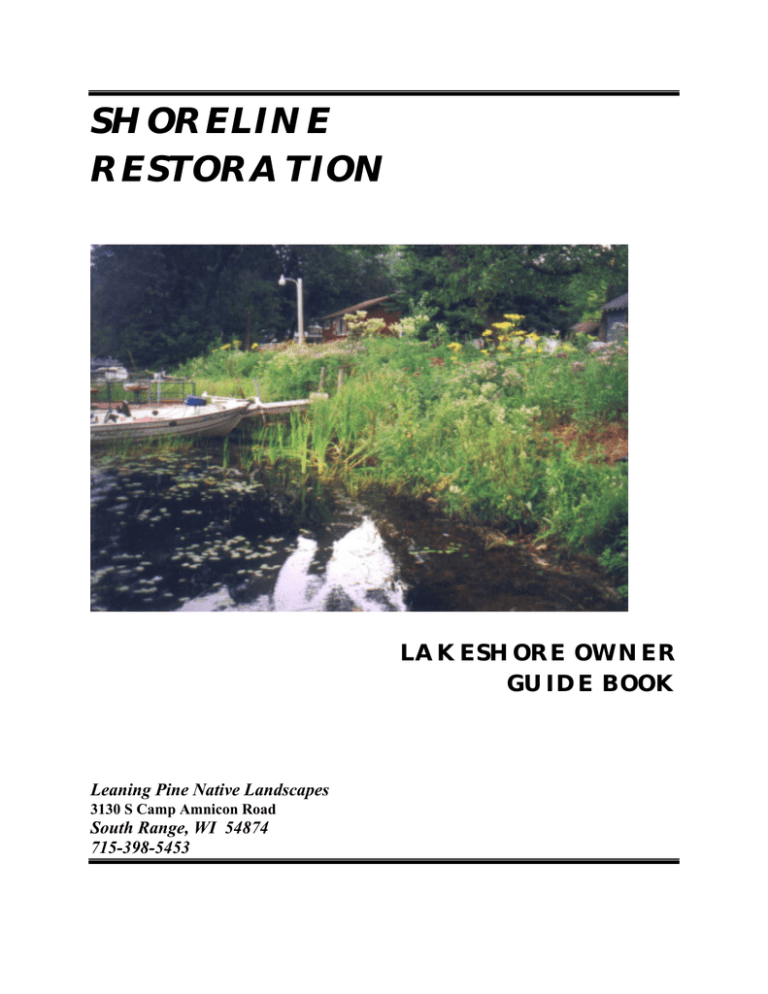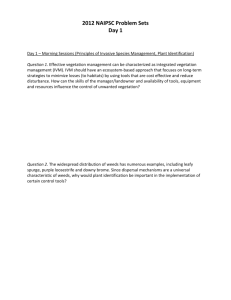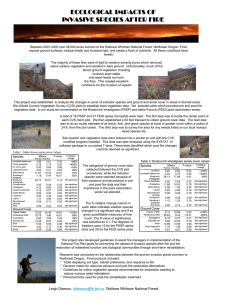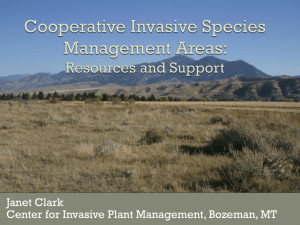SHORELINE RESTORATION LAKESHORE OWNER GUIDE BOOK
advertisement

SHORELINE RESTORATION LAKESHORE OWNER GUIDE BOOK Leaning Pine Native Landscapes 3130 S Camp Amnicon Road South Range, WI 54874 715-398-5453 Table of Contents Why Restoration? . . . . . . . . . . . . . . . . . . . . . . . . . . . . . . . . . 2 Riparian Buffer Strips . . . . . . . . . . . . . . . . . . . . . . . . . . . . . . 3 Why Native Plant Communities? . . . . . . . . . . . . . . . . . . . . . . 4 Site Assessement and Design Planning. . . . . . . . . . . . . . . . . . 5 Site Preparation . . . . . . . . . . . . . . . . . . . . . . . . . . . . . . . . . . 6 Removing existing vegetation . . . . . . . . . . . . . . . . . . . . . . . . . . . . . . . . . . 7 Soil Preparation . . . . . . . . . . . . . . . . . . . . . . . . . . . . . . . . . . . . . . . . . . . . 8 Leave Dead Vegetation in Place . . . . . . . . . . . . . . . . . . . . . . . . . . . . . . . . 8 Live Plant Plug Techniques . . . . . . . . . . . . . . . . . . . . . . . . . . 9 Seeding Techniques . . . . . . . . . . . . . . . . . . . . . . . . . . . . . . . 10 Long Term Care and Maintenance . . . . . . . . . . . . . . . . . . 11-13 Common Weeds to Manage . . . . . . . . . . . . . . . . . . . . . . . 14-17 2 Why Restoration? Shoreline development is at an all time high. Natural shorelines are becoming scarce resources and we are running out of time to protect them. Time after time lakeshores are “cleaned up” by new and old lakeshore property owners alike. The cumulative effect of “cleaning up these riparian areas” has led to declines in water quality, eroding shorelines and disappearing fish and wildlife populations. People soon realized that the natural elements that attracted them to the shore in the first place - clean water, loons, fish, songbirds and peace and quiet - are in significant decline. Many people move to cleaner and quieter lakes, but that option dwindles with each passing year. Studies and surveys have found that over the last twenty years, if building trends continue like they have since the 70’s, all Wisconsin shoreline lakeshores will be developed. In fact northwestern Wisconsin continues to experience the fastest recreational housing growth in the State. 3 Riparian Buffer Strips The riparian area is the strip of land where water meets land near a lake or stream. It can extend into the water and on land for 100’s of feet. This margin of land is where all life comes together… a bridge between two worlds. In a natural state, it consists of an aquatic plant zone at the waters edge, a canopy layer of trees, a subcanopy layer, a shrub layer and groundcovers of grasses and wildflowers on land. It is a place essential for a diversity of plants and animals to survive. In fact 90% of all life found on our lakes and rivers are found in this riparian zone. Riparian areas provide a thick and diverse layers of vegetation that serve to slow water flow allowing runoff water to soak into the soil or be filtered by the vegetation. The deep roots of native grasses and shrubs held to hold soil in place. Soil carries nutrients, which are better kept on shore to grow an 80 feet tall white pine tree, than in the water, where a sea of algae will grow. Screened views are provided by vegetation found in riparian area. Get in your boat and look at your property from the lake. Does it create the northwoods atmosphere you were looking for when you bought property here? 4 Why Native Plant Communities? The greatest advantage to planting natives in a riparian buffer strip is that they require less maintenance (once established) than most non-native species. Through thousands of years, lakeshore plant communities have become adapted to make optimum use of resources such as water and soil, and they further enhance those resources. Soils are built up, water is captured and stored, and wildlife thrives. Layering of different types and ages of plants are chosen to maximize opportunities to restore the ecological function of the lakeshore plant communities. Trees and shrubs along the waters edge provide shade for fish and places for shoreline birds to nest and locate food. Plants in the water and near the shore provide cover for fish, frogs, salamanders, turtles and aquatic insects that are the massive food source of the lake ecosystem. Who has not been touched by the sight of a loon, a heron hunting along the shore, or a bald eagle soaring above the lake? All of these creatures depend on the native grasses, flowers, shrubs, and trees along the shore. 5 Site Assessment and Design Planning The first step in any restoration project is the site assessment. This assessment is vital for selecting the proper plants for the site, identifying existing limitations and clarifying property owner needs and desires. Start your assessment by looking at what native plants remain on your property and how they are arranged. If none remain, find a wild area around the lake that have the same soils (sandy, rocky, mucky, etc.), the same light conditions (full sun, part sun, or shady), same moisture (dry, moist, wet, standing water), and same degree of slope (in and out of water). Pay close attention to how plants grow together, in what combinations and how close together. Equally important is to create a base map of existing conditions on the site. How many docks, boathouses, other structures, and pathways and trails? What is the vegetative make-up of the site and how does it drain? What is the slope of the land and how much sun reaches the ground? What are the soils on the site? Measure the relationship of structures/buildings to the water’s edge, property boundaries, and native plant remnants. Plot out all trees, shrubs and native groundcovers, as well as the extend of an existing lawn in designing the base map. Ask yourself -- Do you need all the structures near the shore? Do you require storage area near the lake? Do you require some lawn for recreational events and family reunions? Can you reduce the amount of lawn, while preserving a spot to sit near the lake in a 30 foot corridor? These are just a small sample of questions you might ask yourself in planning a native landscape. Restoration starts with a foundation. This foundation is a thick cover of vegetation in several layers both in water and on land along the shoreline. For ease of design planning, break the landscape down into distinct planting zones. The first area may be an area in which mowing activities cease. Opportunities for natural regeneration are greatest near the shore and in shallow waters with gradually slopes. Other planting zones may include wet meadow, upland meadow, shrub areas and woodland groundcovers as well as the planting of canopy trees in treeless landscapes. Like people, no two shoreline restored areas will be identical. To meet your needs, budget, and time, planning and forethought is essential. Over time, you will have created a pleasing landscape, while knowing you are doing your part to preserve the lake ecosystem. 6 SITE PREPARATION Proper site preparation is one of the most important steps in establishing a native plant landscape. Take your time, as it can require some effort to prepare the site well. Native plantings can survive on poor, sandy or clay soils and eventually will require little maintenance. However, you must lessen the competition on site by removing the existing vegetation. If left in place turf grasses, for example, can quickly out-compete newly planted native grasses and wildflowers. Sometimes it is possible to plant among existing scattered native vegetation or to leave zones of vegetation intact. The moist zone near the water's edge often consists mostly of native plants because turf grasses are flooded out here. Underground stems and seeds may quickly revegetate the area if allowed to grow. Selected native flowers, grasses, and shrubs can usually be planted among existing vegetation in this zone to get the desired results. Stands of invasive plants like reed canary grass or purple loosestrife are an exception, and should be removed. 7 Removing Existing Vegetation You can remove existing vegetation by smothering, tilling or applying herbicide or a combination of all three. A) Smothering - Use Black Plastic Black plastic spread over vegetation not only eliminates light, but also creates heat that kills seeds, roots, and stems. This method is suitable for almost any site. In areas with high exposure to wind, extra care must be taken to anchor it in place. Explain the purpose of the plastic to your neighbors; they might wonder! 1) You will need: S 3.5 ml or thicker black plastic to adequately cover the area, plus extra to overlap sheets at least 6 inches. S 4 inch or longer U-shaped metal staples (enough to space 1 foot apart where plastic overlaps). S Use heavy objects like logs, cement blocks, boards, or tires to hold the plastic in place. 2) Prepare the site by mowing, weed whacking, or trimming vegetation to be removed. 3) Lay down the black plastic. Get some help and choose a calm day. Overlap the plastic at least 6 inches if using more than one piece. Staple or stake it down. 4) Place heavy objects over plastic to be sure it stays there. 5) Leave in place 4-6 weeks during summer. Make certain there is no sign of living grass before removing it. 6) Remove plastic and plant directly into dead vegetation. Special Note: In full shade areas, smothering with black plastic is less effective and an herbicide application may be necessary. B) Tilling/Cultivation Cultivation should only be used greater than 35ft back from the lake. Consult with Leaning Pine Native Landscapes if you have reason to cultivate closer to the lake. Oftentimes tilling is desirable for large areas over 1500 square feet. However, as a general rule, this option is less desirable than smothering with black plastic. Drawbacks include - potential soil erosion on steep slopes, loss of soil structure, damage to tree roots in shadier sites, and exposure of weed seeds from deeper in the soil. To be successful the site must be tilled several times over a growing season and for aggressive turf/fields it should be done over a year’s period. Till no deeper than 6 inches to avoid stirring up additional weed seeds. Till at a minimum of 1 week intervals to allow annual weed seeds to sprout. Do not chose this method on a steep slope to the lake. Tilling greatly increases susceptibility to erosion. 8 C) Applying Herbicide A glyphosate herbicide like Roundup is safest and best to use. Vegetation must be actively growing, and label instructions should be very carefully followed. Avoid drift of herbicide to water. A Department of Natural Resources permit is required for herbicide use in the water. Roundup only effects plants directly sprayed and does not spread to nearby plants. Within days, Roundup begins to break down into harmless natural materials allowing the area to be re-planted with natives. We recommend waiting 14 to 21 days before planting native plants or preparing the site for seeding native plants. Soil Preparation In most cases soil preparation is not required in planting live native plants. Make sure that native plants are chosen to match the soil, moisture and light conditions on your lakeshore. Adding black dirt, manure, and fertilizers can be detrimental to your lakeshore planting. These soil amendments will favor weed growth. Occasionally, soil amendments are necessary. It is wise to have the soil tested if you have any questions concerning its type, its pH value or its fertility. In highly acidic soils (less than 5.5pH), adding lime should be an asset to your lakeshore planting. Soil amendments may also be required for soils having low to no nutrients. Where fertilizers are necessary as indicated by the results of the soil test, they should never be broadcast due to the potential for runoff into the lake. Instead apply a very small amount on the surface around each plant. Leave Dead Vegetation In Place Dead vegetation caused during site preparation or after the 1st year of growth should be left in place. The dead vegetation will serve as a mulch to capture moisture, reduce weed growth and add organic material to the soil. If using cultivation as your primary method of site preparation, protect your lakeshore on steep slopes by laying down an erosion control mat, and a silt fence at the water line. Open soil can easily erode to the lake. If there is a long delay between cultivation and planting, plant the area in a cover crop of annual oats or rye to protect the area from erosion. 9 Seeding Techniques 1. Remove non-native competing vegetation through smothering, tilling or applying herbicide as described in the site preparation handout. Be sure to remove grass roots. Do not seed into existing vegetation. Rake or till very lightly to expose soil for planting seed. Use 3-5 ounces of seed for every 1,000 square feet. The more seed used, the denser the growth and the chances for better success. 2. Mix seeds with slightly moist sand. Fill an ice cream pail or similar one gallon bucket 2/3 full with moist (not wet) sand. Add seeds and mix well. Diluting the seeds will assure good seed distribution. The seeds will adhere to the sand, so they can be spread more thinly and evenly. 3. Broadcast the seed/sand mixture. Use half of the seed/sand mixture to cover entire area. Then sow the remaining half by walking perpendicular to the line of the first pass. This will assure good seed distribution throughout the area you wish to plant. 4. Tamp down the soil with a rake or lightly rake the seeds in. 5. Roll the site with a water filled roller to insure good soil/seed contact. NEVER roll when wet, this will compact the soil thereby reducing seed germination and levels of oxygen in the soil. 6. Mulch lightly with 1/2 inch of weed free straw, marsh hay, leaves or pine needles depending on lakeshore site. Never use field hay, as it contains numerous weed seeds. 7. On steep slopes, hold the mulch in place by staking down a jute or plastic net/mesh over it. 8. Water. Don’t forget this important step to give your plants a good start! Watering seeds and small seedlings after sprouting is critical. Plan to water daily for the first few weeks or until plants are well established. Water only in the morning for about thirty minutes each day. Once plants are established, water only if prolonged dry periods occur. 9. Weed. These plants will be low maintenance, but it will help to try to eliminate competition from weeds the first season. It is difficult to tell weeds from the natives. Sprouting a small sample of your natives in a plant tray will assist you in their identification, allowing you to identify and pull common weeds. Also pull weeds you recognize in other areas of your lakeshore. Your investment of time will pay off next year and in following years. See more on weeding in Long Term Care and Maintenance section. 10 Long Term Care and Maintenance Introduction Congratulations, you have just finished planting a native landscape. Your ultimate goal now is a continuous, on-going vegetative cover that provide habitat and provides protection for water quality. Do not walk away now. The next two years will require your diligent attention for watering and weeding to insure long-term success. In time, your maintenance duties will ease and you will have time to enjoy the scenic beauty you have brought back to the shoreline. Year One Watering Regular watering in the first two months of a spring or summer planting is one of the most important factors in success. Your young plants’ roots can not reach for the nourishment they need. Watering (at least 30 minutes each day) allows rigorous root growth and for plants to become quickly established. Water only in the morning, never at night, as the reduces evaporation and the chances for fungal diseases to kill young seedlings. Use lake water if feasible, since this water often is warmer and more nutrient rich than well water from the home. 3 Weed Control Native plants are either slow growing or warm season plants. Cool season weeds can crowd out natives by getting a quick start in the Spring before your natives have had a chance to grow. They deprive natives of water, light, nutrients and space. Check for weeds once every two weeds. Pull them out immediately being careful to not disturb the native plants. Do not allow non-native invasive species like purple loosestrife, mullein, lambquarters, quack grass, reed canary grass, bluegrass and others to take over the planting. As the native planting matures, you may need to try spot weeding with Roundup, so as to minimize the impact of hand pulling as roots of native and non-native plants easily become entangled. Try to protect your natives with a cardboard shield during the spot treatment. If weeds get out of hand, you may have to start a mowing program. Consult with Leaning Pine Native Landscapes for further information. Fertilizing And Applying Insecticides DON’T DO IT!!!! If you feel you must, contact Leaning Pine Native Landscapes for advice. Applying fertilizers encourages weed growth. Native plants have evolved with native soils for thousands of years and are able to find the nutrients they require without supplemental fertilization. Also avoid applying insecticides since so many are non-specific and can harm or even kill non target species. Vegetative Cover At the end of the first season, allow all dead vegetation to remain in place. It becomes a valuable seed source for next year’s growth. 4 YEAR TWO If you have been diligent during the first year, the second year’s maintenance task will ease. Watering Water only during periods of severe drought. Weeding Do a thorough weeding job early in the Spring. After this initial weeding, check for weeds once a month. If non-native weeds are still present, pull carefully or treat with Roundup. An occasional dandelion in the middle of a planting should be left in place, as removal will do more harm than good. Vegetative Cover In Spring, cut back vegetation to about 2-3” if so desired. Clippings should be left in place as a mulch and seed source. It is during the second season that you will notice the native planting filling out and becoming rigorous. YEAR THREE AND BEYOND Always start out the season by cutting back vegetation, removing excess plant litter and compost. Weed the entire area thoroughly. For the remaining part of the growing season, weed only if needed as described earlier. No watering should be necessary from now on. Try to leave vegetation in place in the fall and through the winter months. 5 Knotted Knapweed Centaurea biebeersteinii- introduced naturalized, invasive. Kenneth. J. Sytsma Crabgrass Digistria ischaemum-introduced, naturalized. Emmet J. Judziewicz Yellow Rocket Barbarea vulgaris –introduced, naturalized. Stephen L. Solheim Field Bindweed Convolvulus arvensis - introduced naturalized, invasive, noxious weed. Michael Clayton Elytrigia repens – introduced, naturalized, invasive. Kenneth J. Sytsma Quackgrass Chenopodium alba – introduced, naturalized. Elizabeth Parnis Lamb’s Quarters Euphorbia esula – introduced, invasive, noxious weed. Kenneth J. Sytsma Leafy Spurge Cirsium vulgare – introduced, naturalized, invasive. Kenneth J. Sytsma Bull Thistle The weeds found on these pages are often times exotic species that have become naturalized in Wisconsin. They are persistent, aggressive and can outcompete newly planted plants. It is important to learn to recognize these plants and eliminate them from the restored area soon after identification. COMMON INTRODUCED AND ECOLOGICALLY INVASIVE WEEDS 1 Dame’s Rocket Hesperis matronalis- introduced, naturalized, invasive. Hugh H. Iltis Purple Loosestrife Lythrum salicaria- introduced, naturalized, invasive, noxious weed. Kenneth J. Sytsma Creeping Charlie Glechoma hederacea – introduced, naturalized, invasive. Michael Clayton Bird’s Foot Trefoil Lotus corniculata – introduced, naturalized, invasive, noxious weed. USDA – NRCS Melilotus alba – introduced, naturalized, invasive. Kenneth J. Sytsma White Sweet Clover Hieracium aurantiucum-introduced, naturalized, invasive. Merel Black Orange Hawkweed Melilotus officinalis – introduced, naturalized, invasive. Kitty Kohout Yellow Sweet Clover 2 Leucanthemum vulgare-introduced naturalized, invasive. Kenneth J. Sytsma Ox-eye Daisy Reed Canary Grass Phlaris arundinacea – introduced, naturalized, invasive. Stephen L. Solheim Curly Dock Rumex crispus – introduced, naturalized, invasive. Stephen L. Solheim Carpetweed Molluga verticella- introduced, naturalized. Dennis W. Woodland Rough Fruited Cinquefoil Potentilla recta – introduced, naturalized. Robert W. Freckman Kitty Kohout Setaria faberi – introduced, escaped. Foxtail Plantago major- introduced, naturalized, invasive. Elizabeth Parnis Common Plantain Silene (Lynchis) latifolia – introduced, naturalized. Robert W. Freckman Bladder Campion Poa pratense – introduced, naturalized, invasive. Robert W. Freckman Kentucky Blue Grass 3 Common Chickweed Common Chickweed – introduced, naturalized. Richard Bauer Red Clover Trifolium pratense – introduced, naturalized, invasive. Stephen L. Solheim Deadly Nightshade Solonum dulcamara – introduced, naturalized, invasive. Kitty Kohout Poison Ivy Toxicodendron rydbergii – native, potentially invasive. Merel R. Black Trifolium repens – introduced, naturalized, invasive. Robert R. Kowal White Clover Taraxacum officinale – introduced, naturalized. Dennis W. Woodland Dandelion Verbascum thapsis – introduced, naturalized, invasive. Hugh I. Iltis Common Mullein Thlapsis arvense – introduced, naturalized. Kenneth J. Sytsma Field Pennycress 4







